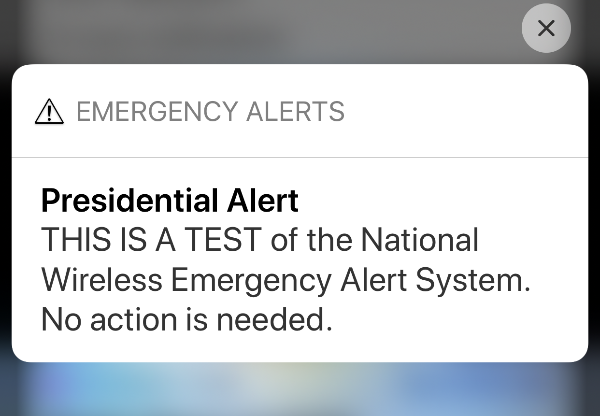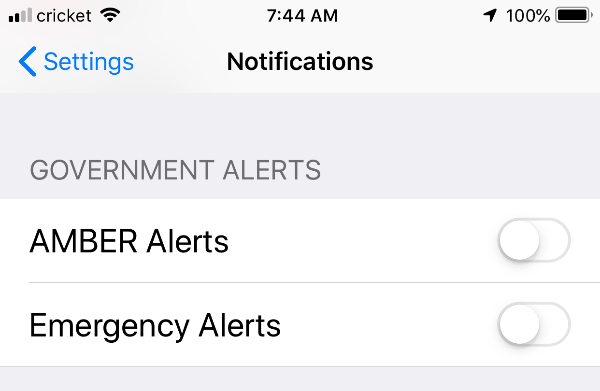- By Dan Veaner
- News
 Print
Print 
At 2:18 Eastern Time Wednesday cell phones across America beeped, honked, rang, and produced that obnoxious 'this is a test of the emergency broadcast system' claxon. If you were alone in your car or at your home it may have been startling, but reports from phone owners at Walmart and other places where lots of people gather say that the effect was startling.
Presidential alerts don't come from the President. Worries that President Trump will be moving his Twitter postings to mandatory alerts on our phones are ill-founded. But the not-entirely clearly titled alert is called a 'Presidential Alert' because FEMA issues it on behalf of the President, a level of alert that citizens can't opt out of. Theoretically a president could use it to address the nation in a real emergency, but the system isn't for tweeting. Wednesday's test was scheduled for September 20th, but postponed because of an actual emergency, Hurricane Florence.
The Emergency Alert System (EAS) is a top-of-the-pyramid alert system managed by the Federal Emergency Management Agency (FEMA). This was the fourth test of the system, but the first to include texting. Last year's test was directed at Cable TV, Internet Protocol Television (IPTV), Broadcast TV, and Radio. But FEMA was not satisfied with the result.
"While the apparent overall quality of the data collected in ETRS has improved FEMA continues to have concerns regarding the quality of EAS Participant responses recorded in ETRS. For example seven EAS Participants indicated that they did not receive the NPT message, but did successfully relay the message they claimed not to receive," said FEMA's final report on the 2017 test.
Then in January of this year Hawaiians received an alert via EAS at 8:07am. The alert read, "BALLISTIC MISSILE THREAT INBOUND TO HAWAII. SEEK IMMEDIATE SHELTER. THIS IS NOT A DRILL". The alert finished with, 'This is not a drill.'
Oops.
38 minutes later a second alert was sent to assure the good folks of Hawaii that the first alert was a false alarm. Evidently the alert was part of a drill that went very, very wrong. During a shift change an employee at the Hawaii Emergency Management Agency goofed, clicking a button to send an actual alert instead of the one for tests, and claimed that during the phone call informing him of the test he hadn't heard the part about it being a test because a fellow employee had switched the call to speakerphone part way through the call.
The incident was widely viewed as a procedural failure of the EAS system.
 You can turn off Amber Alerts. You can turn off Emergency Alerts. But you can't turn off Presidential Alerts.
You can turn off Amber Alerts. You can turn off Emergency Alerts. But you can't turn off Presidential Alerts.Cell phone owners can turn off Amber Alerts and most Emergency Alerts in their phone settings. But Presidential Alerts can not be turned off. Although that didn't prevent some people from trying. A Wired article explained that you could put your phone in Airplane Mode during the half hour of Wednesday's test. It didn't mention another remedy - turning off your phone. But the article noted this only works for tests that are announced beforehand, like Wednesday's test was. You'd have to be clairvoyant to know when to turn your phone off for a real emergency. Of course if that were the case you would most likely already know about the emergency anyway, so you wouldn't need an alert.

While confusion Wednesday wasn't as consequential as that resulting from the Hawaii alert debacle, Twitter, Facebook, and other social media response was immediate and not necessarily well informed. Predictable political comments were plentiful, and some folks thought the President had singled them out for a personal communication. But mostly it was just another thing to talk about in the national conversation.
Some folks see the EAS as an Orwellian intrusion. Others see it as a valuable tool for responding to national emergencies. Walmart shoppers, no doubt, saw it as a lot of sudden noise.
On the serious side, some reports say that if the alert had been a real nuclear strike warning Americans would probably have less than 15 minutes to get to shelter, possibly half that time. FEMA recommends staying inside, preferably with as much concrete and other building materials between you and the radiation outside as possible -- in other words stay in your basement for... well how long would work? And if you were in the missile target area, the Presidential Alert would likely be the last text you receive. A sobering thought.
v14i38
